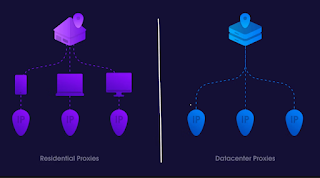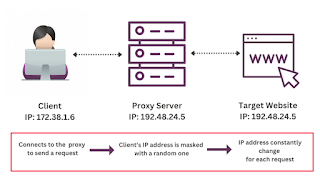

Static Proxies or Rotating Proxies - DZone
source link: https://dzone.com/articles/which-one-you-should-choose-static-proxies-or-rota
Go to the source link to view the article. You can view the picture content, updated content and better typesetting reading experience. If the link is broken, please click the button below to view the snapshot at that time.

Static Proxies or Rotating Proxies: Which One Should You Choose?
This article explains the differences between Static proxies and Rotating proxies. Let's find out what they are.
Data center proxies come from servers in data centers, while residential proxies come from real people's connections. Static proxies mostly come from data centers, while rotating proxies are residential, although there are exceptions for Residential proxies.
Both IPv4 and IPv6 addresses can supply static and rotating proxies, but static IPv4 proxies may be harder to come by since they've all been assigned. IPv6, on the other hand, has trillions of available IP addresses.

What’s a Static Proxy?
A static proxy is a type of proxy server that uses a fixed IP address that does not change. It is usually provided by a data center and is not associated with any particular individual or device.
Static proxies use a fixed IP address throughout the connection, making them less flexible than rotating or mobile proxies, which change IP addresses. The session interval can last from five to 45 minutes or longer.
What’s a Rotating Proxy?
A rotating proxy is a type of proxy server that uses a pool of IP addresses that are constantly changed at regular intervals. This means that each time a user makes a request, the proxy server will use a different IP address from its pool, making it difficult for websites to track.
Static proxies resemble human behavior for websites.

Pros and Cons of Static Proxies
Static proxies have some benefits, such as faster speed, mimicking human behavior, and lower prices. However, they have drawbacks, such as limited range, scalability, and ease of detection.
While they are suitable for some applications like e-commerce, their use may not be ideal for large-scale data collection or web scraping projects. Additionally, their prolonged connections can make them easy to detect and ban.
Pros and Cons of Rotating Proxies
Rotating proxies offer more customization options and scalability for large-scale data collection. They are also harder to detect due to their residential origin and replaceable nature. However, they may have a slower speed and smaller bandwidth than static proxies and come at a higher price point. It's important to consider the specific needs of your project when choosing between the two. If you need access to geo-specific data and scalability for large-scale data collection, rotating proxies may be the better choice.
However, if you require faster speed and more stable connections, static proxies may be the way to go. Additionally, keep in mind that some websites may block visitors based on their location, making static proxies less useful in those situations. Ultimately, the decision between rotating and static proxies comes down to your specific project requirements and budget.
Sticky vs. Rotating Proxies: Uses and Applications
When deciding between static and rotating proxies, it's essential to consider the application's purpose. Static proxies provide a steady, single connection, ideal for multistep interactions while rotating proxies offer more versatility for web scraping and data collection.
Static Proxies
- Static proxies are proxies that use a single IP address throughout a session. They are stable and reliable, making them ideal for a range of applications. E-commerce sites, for instance,
- Static proxies are used for their shopping carts that hold items purchased by customers until they check out.
- Social media bots also prefer static proxies as they resemble human behavior and make crawling social media accounts undetected.
- Marketers can use static proxies to focus their research on a single geographical location, allowing them to see how their audience in that region is being targeted, which gives them a clearer idea of how best to reach them.
- Companies can also use static proxies internally to identify any weaknesses in their tech stack and conduct penetration tests to simulate threats from the outside. Static proxies are effective tools for gathering information on the outside and can keep companies safe.
- Usually, static proxies are cheaper than rotating proxies. Also, Get discounts on rotating proxies while purchasing. These may cost you $1 to $5 per proxy, and it varies with the company.
Rotating Proxies
Rotating proxies are becoming increasingly popular due to their vast number of IP addresses, making them an ideal choice for en masse data collection.
- These proxies are especially useful for web scraping, market research, competitive analysis, and SEO monitoring.
- Competitive analysis is critical to understanding the external conditions potential customers face and the alternative providers you’re competing against.
- By using rotating proxies, companies can scrape pricing data from leading competitors' sites, obtain economic data on the community they plan to enter, and gain insights into the market size, demand, and location. This anonymity could unlock the data needed to enter the market strategically.
- Rotating proxies are also essential for SEO monitoring. Companies can use rotating proxies to scrape their competition's product descriptions to find which keywords are used most, enabling them to create content that better aligns with the language their customers use.
- For web scraping, rotating proxies are the right choice for massive data scraping projects. A large number of IP addresses enables users to make multiple collections simultaneously, allowing them to collect all the data they need.
- Rotating proxies create the appearance of residential user activity, making it harder for certain websites to identify them.
- Rotating proxies are also useful in market research, where marketers can use them to break through geographical boundaries and access data from multiple locations. For instance, a marketing company may want to gather data on a certain demographic based on age wherever their product is sold.
- Rotating proxies can come from all over the globe, allowing marketers to obtain data from different regions.
- Another benefit of rotating proxies for SEO monitoring is that they allow companies to remain anonymous as they research their own company. This helps to safeguard privacy, enabling them to objectively analyze their website without cookies skewing search results.
Final Conclusion
Rotating proxies are the perfect choice for projects that involve big data, market research, competitive analysis, and SEO monitoring. With their vast number of IP addresses, users can make many collections simultaneously without getting detected, making them ideal for large-scale web scraping projects. Furthermore, rotating proxies enable companies to break through geographical boundaries, access data from multiple locations, and remain anonymous while conducting research.
Recommend
About Joyk
Aggregate valuable and interesting links.
Joyk means Joy of geeK